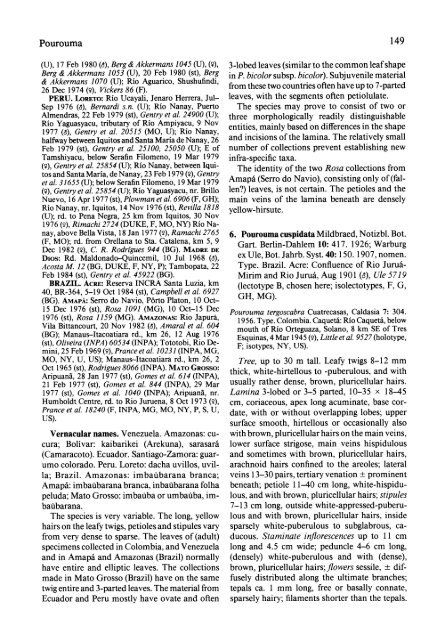Cecropiaceae: Coussapoa and Pourouma, with an ... - CNCFlora
Cecropiaceae: Coussapoa and Pourouma, with an ... - CNCFlora
Cecropiaceae: Coussapoa and Pourouma, with an ... - CNCFlora
You also want an ePaper? Increase the reach of your titles
YUMPU automatically turns print PDFs into web optimized ePapers that Google loves.
<strong>Pourouma</strong><br />
(U), 17 Feb 1980 (6), Berg & Akkerm<strong>an</strong>s 1045 (U), (2), 3-lobed leaves (similar to the common leaf shape<br />
Berg & Akkerm<strong>an</strong>s 1053 (U), 20 Feb 1980 (st), Berg in P. bicolor<br />
& Akkerm<strong>an</strong>s 1070 (U); Rio<br />
subsp. bicolor). Subjuvenile material<br />
Aguarico, Shushufindi,<br />
26 Dec 1974 (2), Vickers 86 from these two countries often have<br />
(F).<br />
up to 7-parted<br />
PERU. LORETO: Rio Ucayali, Jenaro Herrera, Jul- leaves, <strong>with</strong> the segments often petiolulate.<br />
Sep 1976 (6), Bernardi s.n. (U); Rio N<strong>an</strong>ay, Puerto The species may prove to consist of two or<br />
Almendras, 22 Feb 1979 (st), Gentry et al. 24900 (U); three morphologically readily distinguishable<br />
Rio Yaguasyacu, tributary of Rio Ampiyacu, 9 Nov<br />
1977 (6), Gentry et al. 20515 (MO, U); Rio entities,<br />
N<strong>an</strong>ay,<br />
mainly based on differences in the shape<br />
halfway between Iquitos <strong><strong>an</strong>d</strong> S<strong>an</strong>ta Maria de N<strong>an</strong>ay, 26 <strong><strong>an</strong>d</strong> incisions of the lamina. The relatively small<br />
Feb 1979 (st), Gentry et al. 25100, 25050 (U); E of number of collections prevent establishing new<br />
Tamshiyacu, below Serafin Filomeno, 19 Mar 1979 infra-specific taxa.<br />
(2), Gentry et al. 25854 (U); Rio N<strong>an</strong>ay, between Iqui- The<br />
tos <strong><strong>an</strong>d</strong> S<strong>an</strong>ta Maria, de N<strong>an</strong>ay, 23 Feb 1979 identity of the two Rosa collections from<br />
(2), Gentry<br />
et al. 31655 (U); below Serafin Filomeno, 19 Mar 1979 Amapa (Serro do Navio), consisting only of (fal-<br />
(2), Gentry et al. 25854 (U); Rio Yaguasyacu, nr. Brillo len?) leaves, is not certain. The petioles <strong><strong>an</strong>d</strong> the<br />
Nuevo, 16 Apr 1977 (st), Plowm<strong>an</strong> et al. 6906 (F, GH); main veins of the lamina beneath are densely<br />
Rio N<strong>an</strong>ay, nr. Iquitos, 14 Nov 1976 (st), Revilla 1818<br />
yellow-hirsute.<br />
(U); rd. to Pena Negra, 25 km from Iquitos, 30 Nov<br />
1976 (9), Rimachi 2724 (DUKE, F, MO, NY) Rio N<strong>an</strong>ay,<br />
above Bella Vista, 18 J<strong>an</strong> 1977 (2), Ramachi 2765 6. <strong>Pourouma</strong> cuspidata Mildbraed, Notizbl. Bot.<br />
(F, MO); rd. from Orell<strong>an</strong>a to Sta. Catalena, km 5, 9<br />
Gart. Berlin-Dahlem 10: 417.<br />
Dec 1982 (2), C. R. Rodrigues 944 (BG). MADRE 1926;<br />
DE<br />
Warburg<br />
Dios: Rd. Maldonado-Quincemil, 10 Jul 1968 (6),<br />
ex Ule, Bot. Jahrb. Syst. 40:150. 1907, nomen.<br />
Acosta M. 12 (BG, DUKE, F, NY, P); Tambopata, 22 Type. Brazil. Acre: Confluence of Rio Jurua-<br />
Feb 1984 (st), Gentry et al. 45922 (BG).<br />
Mirim <strong><strong>an</strong>d</strong> Rio Juruf, Aug 1901 (6), Ule 5719<br />
BRAZIL. ACRE: Reserva INCRA S<strong>an</strong>ta Luzia, km<br />
40, BR-364, 5-19 Oct 1984 (st), Campbell et al. 6927<br />
(lectotype B, chosen here; isolectotypes, F, G,<br />
(BG). AMAPA: Serro do Navio, P6rto Platon, 10 Oct- GH, MG).<br />
15 Dec 1976 (st), Rosa 1091 (MG), 10 Oct-15 Dec <strong>Pourouma</strong><br />
1976 (st), Rosa 1159 (MG). AMAZONAS: Rio tergoscabra Cuatrecasas, Caldasia 7: 304.<br />
Japura, 1956.<br />
Vila Bitt<strong>an</strong>court, 20 Nov 1982 (8), Amaral et al. 604<br />
Type. Colombia. Caqueta: Rio Caqueta, below<br />
mouth of Rio<br />
(BG); M<strong>an</strong>aus-Itacoatiara rd., km 26, 12 Aug 1976<br />
Orteguaza, Sol<strong>an</strong>o, 8 km SE of Tres<br />
(st), Oliveira (INPA) 60534 (INPA); Tototobi, Rio De- Esquinas, 4 Mar 1945 (v), Little et al. 9527 (holotype,<br />
mini, 25 Feb 1969 (9), Pr<strong>an</strong>ce et al. 10231<br />
F; isotypes, NY, US).<br />
(INPA, MG,<br />
MO, NY, U, US); M<strong>an</strong>aus-Itacoatiara rd., km 26, 2 Tree, up to 30 m tall. Leafy twigs 8-12 mm<br />
Oct 1965 (st), Rodrigues 8066 (INPA). MATO GROSSO:<br />
Aripu<strong>an</strong>a, 28 J<strong>an</strong> 1977 (st), Gomes et al. 614 thick, white-hirtellous to -puberulous, <strong><strong>an</strong>d</strong> <strong>with</strong><br />
(INPA),<br />
21 Feb 1977 (st), Gomes et al. 844 (INPA), 29 Mar usually rather dense, brown, pluricellular hairs.<br />
1977 (st), Gomes et al. 1040 (INPA); Aripu<strong>an</strong>a, nr. Lamina 3-lobed or 3-5 parted, 10-35 x 18-45<br />
Humboldt Centre, rd. to Rio Juruena, 8 Oct 1973 (2), cm, coriaceous, apex long acuminate, base cor-<br />
Pr<strong>an</strong>ce et al. 18240 (F, INPA, MG, MO, NY, P, S, U, date, <strong>with</strong> or <strong>with</strong>out overlapping lobes; upper<br />
US).<br />
surface smooth, hirtellous or occasionally also<br />
Vernacular names. Venezuela. Amazonas: cu- <strong>with</strong> brown, pluricellular hairs on the main veins,<br />
cura; Bolivar: kaibarikei (Arekuna), sarasara lower surface strigose, main veins hispidulous<br />
(Camaracoto). Ecuador. S<strong>an</strong>tiago-Zamora: guar- <strong><strong>an</strong>d</strong> sometimes <strong>with</strong> brown, pluricellular hairs,<br />
umo colorado. Peru. Loreto: dacha uvillos, uvil- arachnoid hairs confined to the areoles; lateral<br />
la; Brazil. Amazonas: imbaubar<strong>an</strong>a br<strong>an</strong>ca; veins 13-30 pairs, tertiary venation + prominent<br />
Amapa: imbaubar<strong>an</strong>a br<strong>an</strong>ca, inbaubar<strong>an</strong>a folha beneath; petiole 11-40 cm long, white-hispidupeluda;<br />
Mato Grosso: imbaiuba or umbauiba, im- lous, <strong><strong>an</strong>d</strong> <strong>with</strong> brown, pluricellular hairs; stipules<br />
baubar<strong>an</strong>a.<br />
7-13 cm long, outside white-appressed-puberu-<br />
The species is very variable. The long, yellow lous <strong><strong>an</strong>d</strong> <strong>with</strong> brown, pluricellular hairs, inside<br />
hairs on the leafy twigs, petioles <strong><strong>an</strong>d</strong> stipules vary sparsely white-puberulous to subglabrous, cafrom<br />
very dense to sparse. The leaves of (adult) ducous. Staminate inflorescences up to 11 cm<br />
specimens collected in Colombia, <strong><strong>an</strong>d</strong> Venezuela long <strong><strong>an</strong>d</strong> 4.5 cm wide; peduncle 4-6 cm long,<br />
<strong><strong>an</strong>d</strong> in Amapa <strong><strong>an</strong>d</strong> Amazonas (Brazil) normally (densely) white-puberulous <strong><strong>an</strong>d</strong> <strong>with</strong> (dense),<br />
have entire <strong><strong>an</strong>d</strong> elliptic leaves. The collections brown, pluricellular hairs; flowers sessile, + difmade<br />
in Mato Grosso (Brazil) have on the same fusely distributed along the ultimate br<strong>an</strong>ches;<br />
twig entire <strong><strong>an</strong>d</strong> 3-parted leaves. The material from tepals ca. 1 mm long, free or basally connate,<br />
Ecuador <strong><strong>an</strong>d</strong> Peru mostly have ovate <strong><strong>an</strong>d</strong> often sparsely hairy; filaments shorter th<strong>an</strong> the tepals.<br />
149
















